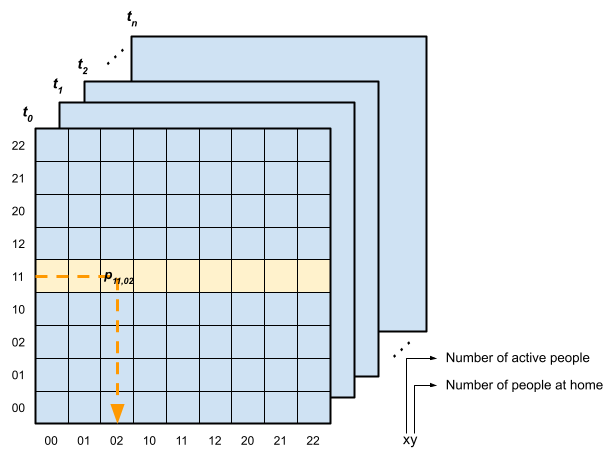Occupancy and activity¶
These modules allow to simulate household occupancy and activity behaviour with a 10 min time resolution. They uses a Markov chain technique to create stochastic profiles using transition probability matrices based on time use survey data.
Two alternative modules are currently available in demod:
4-states occupancy simulator¶
- API
For details about the implementation of this simulator you can visit
Crest4StatesModel.- Description
This module is based on a first-order non-homogeneous Markov chain model, developed by [McKenna2016]. According to this approach, the occupancy status of each resident is defined by the activity status (active or asleep) and location (home or away from home). Therefore, there can be
 different states:
(i) at home and active, (ii) at home and asleep, (iii) away from home
and active, or (iv) away from home and asleep.
The model is non-homogeneous because the coefficients of the transition
probability matrix (TPM) change throughout the day with a timestep
of 10 min.
different states:
(i) at home and active, (ii) at home and asleep, (iii) away from home
and active, or (iv) away from home and asleep.
The model is non-homogeneous because the coefficients of the transition
probability matrix (TPM) change throughout the day with a timestep
of 10 min.This approach has the advantage of ensuring greater accuracy in simulating shared family activities such as mealtime. However as the number of family members increases the size of TPMs grows exponentially making proper parameterization difficult. For a household with N members, the TPM size can be calculated as
 .
Moreover, this approach does not allow for tracking behavioral profiles
of individual residents,
as household occupancy data are provided at aggregate level.
.
Moreover, this approach does not allow for tracking behavioral profiles
of individual residents,
as household occupancy data are provided at aggregate level.For illustrative purposes, a graphic representation of the matrix in the case of a two-person household is shown in Fig. 2.

Fig. 2 Transition probability matrices for a two-person household¶
- Availability
This simulator is available for UK and German households. However, modeling behavior heterogeneity based on socio-economic groups is only available for German households.
Transit occupancy simulator¶
- API
For details about the implementation of this simulator you can visit
SparseTransitStatesSimulator.- Description
This approach extend the 4-states occupancy simulator by distinguishing between ‘away for work’ and ‘away for other’. This new version of the model considers three location alternatives and thefore, it may be more appropriate for integrating driving and charging modules for electric vehicles.
In this case the size of TPMs is equal to
 .
The first term of the product stands for the number of active/asleep people,
while the second term corresponds to their location and
is calculated as the combination with repetition of class N and
a set of 3 alternatives (i.e., ‘home’, ‘away for work’ and ‘away for other’),
.
The first term of the product stands for the number of active/asleep people,
while the second term corresponds to their location and
is calculated as the combination with repetition of class N and
a set of 3 alternatives (i.e., ‘home’, ‘away for work’ and ‘away for other’),
 .
.- Availability
This simulator is currently only available for German households.
Other occupancy/activity simulators¶
Demod’s modular structure allows new simulation modules to be introduced and tested for performance, such as explit activity simulation (e.g., see [Yamaguchi2020] ).
At the moment these modules are not available, but they are part of the demod development plan. If you would like to contribute to the development of new modules, please do not hesitate to contact the demod team.
Warning
For data compatibility reasons, explicit activity modeling requires to develop new dedicated modules for simulating electric and thermal demand (see How appliances are simulated for additional info).